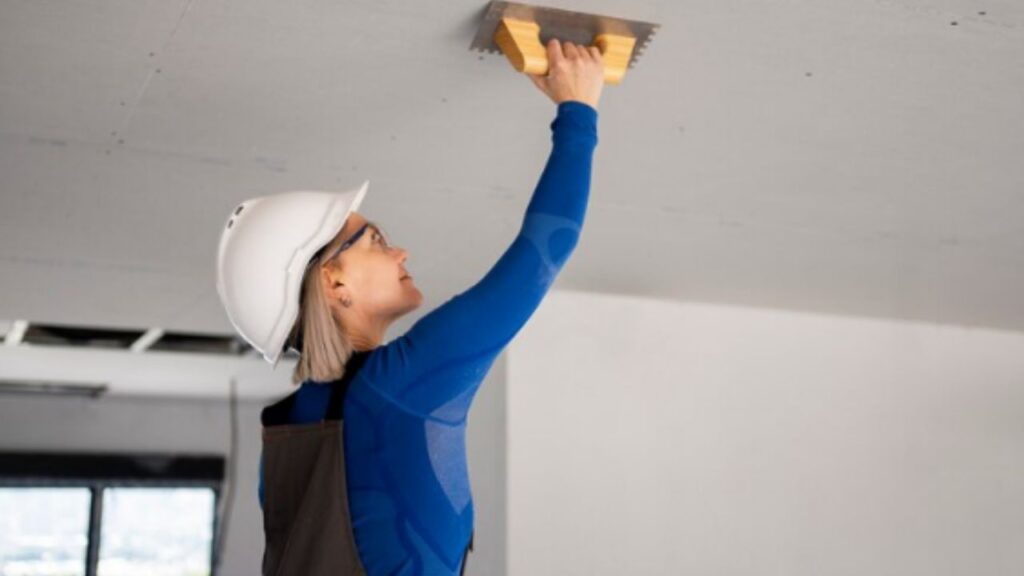Ceiling leaks can be one of the biggest headaches if not dealt with on time. Ignoring leaks may lead to mold, damaged drywall, or structural problems. But don’t worry. Many ceiling leaks can be fixed with simple tools and steps. In this guide, you’ll learn how to repair a ceiling leak yourself. Follow the steps below to tackle the issue.
1. Find the Source of the Leak
To begin the repair, one has to find the source of the leak. Without fixing the source, any repair to the ceiling won’t last. Here’s how:
- Inspect the roof: Roof issues are usually the most common causes of ceiling leaks. If you notice leaks after rain, check for missing shingles or broken flashing.
- Check plumbing: The water leak could be due to a pipe breakage or leakage at the connection point. Any plumbing around the leak area needs to be looked at.
- Check for condensation: Most of the time, air conditioning ducts and equipment drip from condensation, particularly if your climate is humid.
Once you have found the source, proceed with the next step.
2. Prepare the Area
Preparation is the first step in commencing a repair. Preparation will prevent further damage and make the process of repair easy.
- Turn off the water supply: If the leak is from plumbing, then turn off the water supply. This action will stop more water from churning through.
- Remove furniture: Move furniture or other items away from where the wetness is. If unable to move the item, cover them with plastic sheets to protect them.
- Protect the floor: Place a drop cloth or plastic tarp on the floor to catch all debris and water from the repair.
3. Dry out the Area
If the area is left wet, then mold or mildew will be the after-effect of water damage. You should dry the ceiling before starting any kind of repair work.
- Ventilate the room: Open windows or use fans to improve ventilation.
- Use towels or sponges: Mop up the standing water with towels or sponges.
- Apply a dehumidifier: If possible, use a dehumidifier to speed up the drying process.
Let the ceiling be completely dried out before proceeding with the next step.
4. Remove the Damaged Ceiling Material
If the ceiling is sagging, stained, or soft, you’ll want to take out the damaged portion of it so that you can gauge how much damage there is and make the proper repairs.
- Damaged drywall: Cutting out the ceiling’s damaged part with the use of a utility knife; just cut that area and nothing more.
- Mold check: Check the ceiling or above the structure if there is mold or mildew formation. Clean with a mold cleaner.
- Inspect joists: Check the wood joists above the ceiling if there is water damage. If wet, let them dry up completely before continuing.
5. Leak Source Repair
Now that the damages are removed, it’s about time to fix the source of the leak. Ceiling leak repair would vary depending on the source of the water.
- Roof leaks: If the leak is from the roof, then replace the missing shingles or fix the damaged flashing. You may need to call a roofer if the damage is serious.
- Plumbing leaks: Look for loose connections or broken pipes and tighten or replace them. If you have any doubts as to how plumbing repairs are made, call in a pro.
- Condensation issues: Such issues are solved through insulating pipes or ducts to prevent a build-up of condensation. You may want to see whether your air conditioning system needs repairs.
6. Patch the Ceiling
Once you’ve had a chance to fix the source of the ceiling leak, you can start patching up the ceiling. You are now restoring your ceiling to its original look and preventing further damage.
- Drywall patch: Measure the hole and cut out a patch of drywall that fits in. The patch should be smaller than the hole.
- Attach the patch: Using drywall screws, attach the patch to the ceiling joists. Draw the patch tight and even with surrounding drywall.
- Apply joint compound: Spread the joint compound over the edges of the patch. Smooth off with a putty knife. Allow the compound to dry for at least 24 hours.
7. Sand and Paint the Ceiling
Now, after the compound has dried, it is time to sand and paint the ceiling so that the patch will blend in with the rest of the ceiling.
- Smoothen the patch: Take fine-grit sandpaper and sand the patch. Don’t overdo it; just a light touch will do.
- Prime the area: Cover it with a coat of primer. This will make the paint adhere well and not show the repair.
- Painting the ceiling: Once the primer has dried, paint the patched area the same color as the rest of the ceiling to give it a seamless finish.
8. Further Leak Check
When the ceiling leak repair is complete, further leak checks must be performed. You have to make sure the problem is fully fixed.
- Monitor after rain: It is essential to make sure the leak was just a roof issue. Check on the ceiling after a subsequent rainstorm.
- Check plumbing: If the leak is plumbing-related, turn the water back on and watch the area again for further signs of water.
- Watch for mold: Be concerned about any new stains and mold growth- a sure sign of an ongoing moisture problem.
9. Prevent Future Leaks
Now, that the ceiling’s fixed, it’s time to avoid future leaks. Preventive measures reduce the time and money spent later.
- Regular roof check: At least once a year, most should check the roof for any signs of damage or wear. Replace missing shingles or cracked flashing.
- Maintain plumbing: Also, keep an eye out for your plumbing system. Immediately repair small leaks to avoid big problems.
- Improve ventilation: Proper ventilation can dispel problems of condensation. Ensure you ventilate your house properly, especially in the attic.
Conclusion
Ceiling leaks can be quite frustrating; surely, they are tasks a person could handle on his own with merely correct steps. You can save your home from further water damage by finding the cause, making repairs, and taking measures to prevent it. Just follow this step-by-step guide, and in no time, your ceiling will look just like new.






